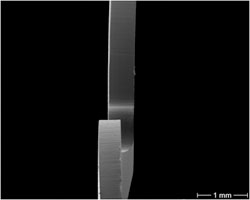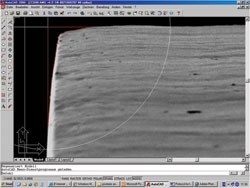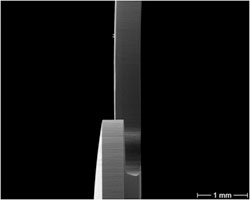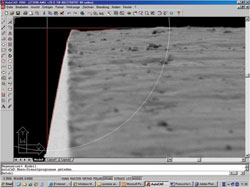How square is a square edge?
A square-edge design is the most important element in arresting lens epithelial cell growth and migration.
 Liliana Werner |
Posterior capsule opacification is the most common complication of cataract surgery with IOL implantation. Lens epithelial cell proliferation and migration are the key pathogenesis of PCO as well as anterior capsule opacification. While we are already experiencing a significant decline in the incidence of PCO, we continue to learn more about the importance of IOL shape and material and the role they play in the prevention of lens epithelial cell migration.
Benefits of a square edge
The benefits of a truncated square optic edge were initially discussed by Nishi and colleagues in articles related to PCO. Additional clinicopathological studies we conducted, as well as other studies, confirm that a square-edged design may work in three synergistic ways: It exerts a mechanical barrier effect, it creates contact inhibition of migrating lens epithelial cells, or LECs, at the capsular bend, and it exerts higher pressures on the posterior capsule. All of these prevent growth and migration of LECs, and thus reduce the incidence of PCO.
More recent studies bring to light the importance of the lens edge being as close as possible to a true square. A study by Tetz and Wildeck evaluated 11 PMMA IOLs specifically manufactured for the study for both the optic edge design as well as its ability to stop cell growth. The EPCO 2000 software measured the difference between the actual lens edge and a true square, and the lens edge’s ability to stop cell growth was observed by placing each IOL into a cell culture and observing cell growth. The authors found that the edge design that effectively stopped cell growth was characterized by an area above the edge of 13.5 µm2 at the most, translating to the closest to a true square edge.
Assessing squareness
I subsequently worked with Tetz to compare the square edges of commercially available hydrophobic acrylic and silicone lenses. Sixteen different designs, each with a 20 D lens and a 0 D lens, were imaged with scanning electron microscopy (Hitachi S-2700 SEM). The images were imported into an AutoCAD LT 2000 system (Autodesk) and the area deviating from square above the posterior-lateral edge was measured. The results showed that a huge variation exists among lenses that claim to have a square-edge design. The area of deviation from a perfect square ranged from 4.8 µm2 to 338.4 µm2 with a 40-µm radius reference circle and from 0.2 µm2 to 524.4 µm2 with a 60-µm radius circle. The edges were compared to an experimental square-edged PMMA reference IOL with an edge design that effectively stopped LEC growth in culture in a preliminary study. The deviation area from the square-edged PMMA IOL was 34.0 µm2 with a 40-µm radius circle and 37.5 µm2 with a 60-µm radius circle. Of the 30 lenses evaluated, only seven lenses of five different designs had area values that were smaller or in the vicinity of the reference square-edged PMMA IOL.
|
|
|
|
|
|
|
Evaluation of the microedge structure of the
ZCB00 single-piece hydrophobic acrylic IOL. The arrows on the left show the
area of analysis on each lens. The photos on the right are high magnification
of the posterior-lateral edges of the lenses.
Images: Werner L |
|
In comparing the high diopter lenses with the low diopter lenses, the differences were not statistically significant. Among few other silicone designs, the 5 D Tecnis Z9002 aspheric silicone lens (Abbott Medical Optics) actually proved to be closer to a true square than the baseline PMMA IOL with only 17.7 µm2 of deviation with a 40-µm radius and 21.7 µm2 with a 60-µm radius. More recently, we evaluated the edges of the new single-piece hydrophobic acrylic Tecnis lens (AMO; model ZCB00), by using the same methodology as described above. Deviations were 66.49 µm2 for the 6 D lens and 154.94 µm2 for the 20 D lens with a 40-µm radius circle. These lenses were therefore among the hydrophobic acrylic lenses with the squarest edges, in comparison to the hydrophobic acrylic lenses included in our peer-reviewed publication.
Lens fixation
An important element in preventing LEC growth, and thus migration, is the overall fixation of the lens. The “shrink-wrap” effect, leading to tight adhesion of the IOL optic to the posterior capsule, leaving no room for cell growth, is considered key in preventing PCO. Initially, it was thought that lens material could compromise this bond. Hydrophilic lenses were considered to not adhere as tightly to the posterior capsule as hydrophobic lenses. However, our recent evaluation of 24 different hydrophilic acrylic IOLs shows that as a group, hydrophilic lenses have much rounder edges. We evaluated 20 D and 0 D lenses of 24 different designs using the same methods as with the hydrophobic lenses. The deviation from a perfect square among the IOLs studied ranged from 60.84 µm2 to 871.51 µm2 for the +20 D IOLs and from 35.52 µm2 to 826.55 µm2 for the low-diopter IOLs. Similar conclusions were drawn from another study. As the square edge plays such an important role in LEC growth and migration, the inherently rounder edges of the hydrophilic lenses invalidate any other comparison regarding the material’s contribution to PCO.
In studies on rabbit eyes with both single-piece hydrophobic and hydrophilic IOLs, it was observed that when LEC migration begins, it tends to begin at the optic-haptic junction. Histopathology studies confirmed the role of the optic-haptic junction as the initial site for LEC growth and migration in some single-piece acrylic IOLs. This phenomenon was not seen in three-piece acrylic lenses. This increases the importance of focusing lens design to reinforce the barrier to LEC migration at the optic-haptic junction. The new single-piece hydrophobic acrylic Tecnis lens incorporates an uninterrupted 360° barrier edge, which extends over the optic-haptic junction. A recently published paired-eye clinical study showed significantly less PCO with this new design in comparison with a one-piece interrupted-edge hydrophobic acrylic IOL 2 years after implantation.
These studies validate the fact that the square edge design is the most important element to arresting LEC growth and migration and thus preventing PCO. Research on the prevention of postoperative capsular bag opacification is increasing in importance as cataract surgical intervention trends toward younger patients, thus increasing in relevance the variations between all the square-edged designs currently available commercially.
References:
- Apple DJ. Influence of intraocular lens material and design on postoperative intracapsular cellular reactivity. Trans Am Ophthalmol Soc. 2000;98:257-283.
- Apple DJ, Peng Q, Visessook N, et al. Eradication of posterior capsule opacification. Documentation of a marked decrease in Nd:YAG laser posterior capsulotomy rates noted in an analysis of 5416 pseudophakic human eyes obtained postmortem. Ophthalmology. 2001;108(3):505-518.
- Boyce JF, Bhermi GS, Spalton DJ, El-Osta AR. Mathematical modeling of the forces between an intraocular lens and the capsule. J Cataract Refract Surg. 2002;28(10):1853-1859.
- Cheng JW, Wei RL, Cai JP, et al. Efficacy of different intraocular lens materials and optic edge designs in preventing posterior capsular opacification: a meta-analysis. Am J Ophthalmol. 2007;143(3):428-436.
- Kugelberg M, Wejde G, Jayaram H, Zetterström C. Posterior capsule opacification after implantation of a hydrophilic or a hydrophobic acrylic intraocular lens: one-year follow-up. J Cataract Refract Surg. 2006;32(10):1627-1631.
- Nanavaty MA, Spalton DJ, Boyce J, et al. Edge profile of commercially available square-edged intraocular lenses. J Cataract Refract Surg. 2008;34(4):677-686.
- Nishi O, Nishi K. Preventing posterior capsule opacification by creating a discontinuous sharp bend in the capsule. J Cataract Refract Surg. 1999;25(4):521-526.
- Nishi O, Nishi K, Akura J, Nakata T. Effect of round-edged acrylic intraocular lenses on preventing posterior capsule opacification. J Cataract Refract Surg. 2001;27(4):608-613.
- Nixon DR, Woodcock MG. Pattern of posterior capsule opacification models 2 years postoperatively with 2 single-piece acrylic intraocular lenses. J Cataract Refract Surg. 2010;36(6):929-934.
- Peng Q, Visessook N, Apple DJ, et al. Surgical prevention of posterior capsule opacification. Part 3: Intraocular lens optic barrier effect as a second line of defense. J Cataract Refract Surg. 2000;26(2):198-213.
- Richter-Mueksch S, Kahraman G, Amon M, Schild-Burggasser G, Schauersberger J, Abela-Formanek C. Uveal and capsular biocompatibility after implantation of sharp-edged hydrophilic acrylic, hydrophobic acrylic, and silicone intraocular lenses in eyes with pseudoexfoliation syndrome. J Cataract Refract Surg. 2007;33(8):1414-1418.
- Tetz M, Wildeck A. Evaluating and defining the sharpness of intraocular lenses: part 1: Influence of optic design on the growth of the lens epithelial cells in vitro. J Cataract Refract Surg. 2005:31(11):2172-2179.
- Werner L, Mamalis N, Izak AM, et al. Posterior capsule opacification in rabbit eyes implanted with 1-piece and 3-piece hydrophobic acrylic intraocular lenses. J Cataract Refract Surg. 2005;31(4):805-811.
- Werner L, Mamalis N, Pandey SK, et al. Posterior capsule opacification in rabbit eyes implanted with hydrophilic acrylic intraocular lenses with enhanced square edge. J Cataract Refract Surg. 2004;30(11):2403-2409.
- Werner L, Müller M, Tetz M. Evaluating and defining the sharpness of intraocular lenses. Microedge structure of commercially available square-edged hydrophobic lenses. J Cataract Refract Surg. 2008;34(2):310-317.
- Werner L, Tetz M, Feldmann I, Bückner M. Evaluating and defining the sharpness of the intraocular lenses: microedge structure of commercially available square-edged hydrophilic intraocular lenses. J Cataract Refract Surg. 2009;35(3):556-566.
- Liliana Werner, MD, PhD, can be reached at the John A. Moran Eye Center, 65 Mario Capecchi Drive, Salt Lake City, UT 84132; 801-581-2352; fax: 801-581-3357; e-mail: liliana.werner@hsc.utah.edu.
- Disclosure: Dr. Werner is a consultant for and recipient of grant support from Abbott Medical Optics.





